Table of contents
- Reportage Brembo in the MotoGP What matters when it comes to MotoGP brakes
- “The brakes are the most important thing”
- Cal Crutchlow is a brute brakes
- Crutchlow is the toughest tester. And crazy.
- Fat 340 millimeter discs for Motegi
- Rear brake as traction control
- How much does a MotoGP brake system cost?
- Top values MotoGP brakes
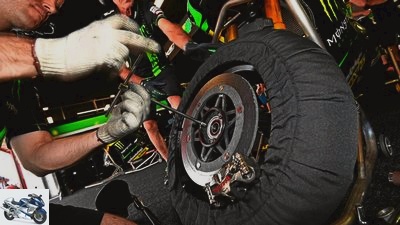
PSP / LukaszSwiderek
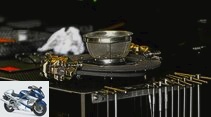
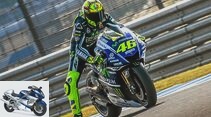
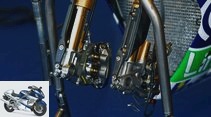
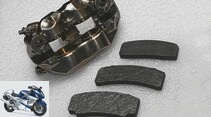
12th pictures
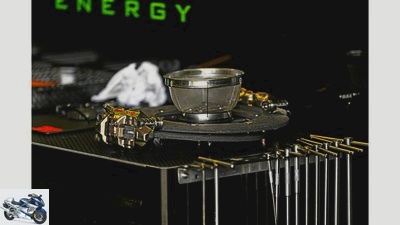
2snap
1/12
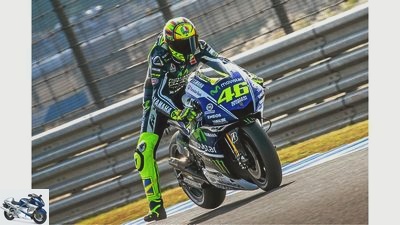
2snap
2/12
The rear brake is hardly required for decelerating. However, it often functions as a foot-operated traction control.
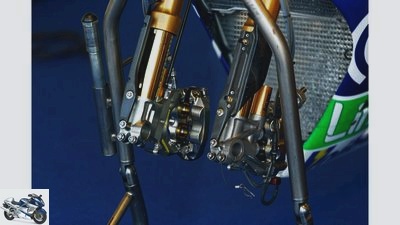
2snap
3/12
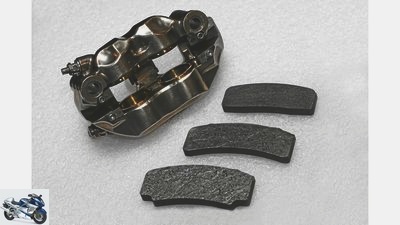
2snap
4/12
Different brake pads are also available for the different brake discs.
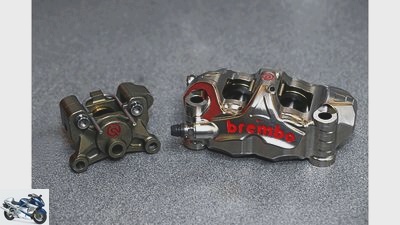
2snap
5/12
Brembo brake calipers for the rear wheel (left) and the front wheel of a MotoGP bike. It should be clear who has to do more here.
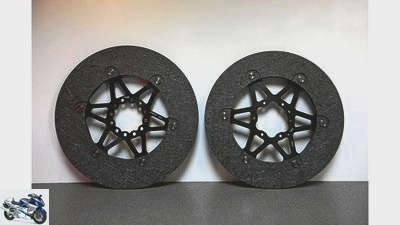
2snap
6/12
Carbon brake discs for MotoGP motorcycles are available with 340 (left) and 320 millimeters in diameter – depending on requirements.
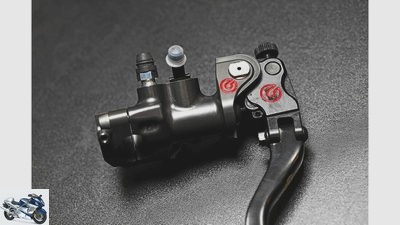
2snap
7/12
The Brembo MotoGP master cylinder is always 19 millimeters in diameter. The distance between the fulcrum and the piston rod can be 18 or 20 millimeters.
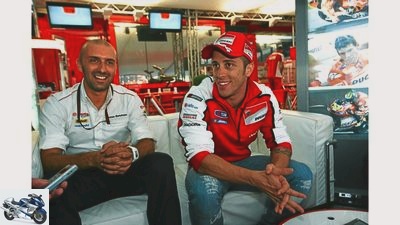
2snap
8/12
Lorenzo Bortolozzo (left) on Ducati works rider Andrea
Dovizioso: “He operates the brakes with a lot of feeling.”

2snap
9/12
Slightly glowing carbon brake discs at Pol Espargaró: This phenomenon can only be seen during the night race in Qatar, never in daylight.
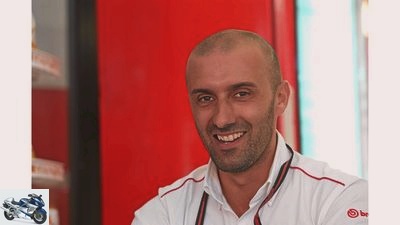
2snap
10/12
Lorenzo Bortolozzo is the Brembo governor in the MotoGP paddock. His job is to communicate with the teams.
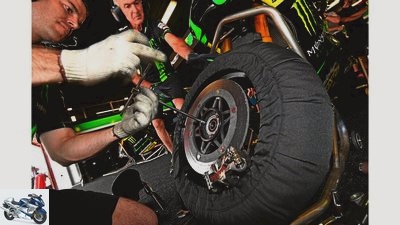
2snap
11/12
Engine, chassis, aerodynamics, tires, control electronics – there are a number of important components on a MotoGP motorcycle.
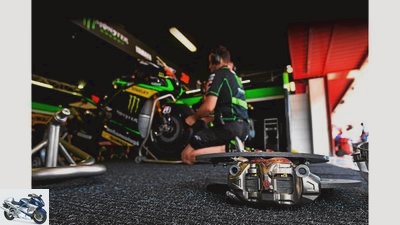
2snap
12/12
Sports & scene
Motorsport
What matters when it comes to MotoGP brakes
Reportage Brembo in the MotoGP
What matters when it comes to MotoGP brakes
Brembo is almost a monopoly in the MotoGP paddock. Brembo engineer Lorenzo Bortolozzo reveals what MotoGP brakes are all about.
Andreas Schulz
01/08/2015
Engine, chassis, aerodynamics, tires, control electronics – there are a number of important components on such a MotoGP motorcycle, all of which are only aimed at one goal. To catapult a 160 kilogram vehicle and its 60 kilogram driver to the highest possible speed in the shortest possible time. And then the brakes come into play, which have nothing else to do than destroy the kinetic energy generated in the clever interplay of all other systems as effectively as possible.
Buy complete article
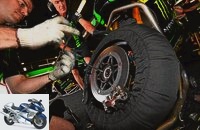
Reportage Brembo in the MotoGP
What matters when it comes to MotoGP brakes
6 pages) as PDF
€ 2.00
Buy now
Incredibly effective. “The tremendous performance is a shock at first,” said MotoGP climber Jack Miller after his first laps on the MotoGP Honda. “But after two or three laps you get used to it. But there is nothing that prepares you for the braking force! ”Someone who should know once put it differently. “The brakes on a MotoGP motorcycle do twice as much as the engine.” Eugenio Gandolfi, the former head of racing at the Italian brake manufacturer Brembo, knew exactly what he was talking about. An example: a powerful 800 meters of the 1.1 kilometer straight in Mugello, the longest on the GP calendar, are used to accelerate a MotoGP machine from around 130 km / h to 360 km / h. The brakes are then about 320 meters available to turn it into the manageable speed of 120 km / h in turn one. To ask?
KTM enters MotoGP
Image galleries: Grid Girls in MotoGP
“The brakes are the most important thing”
“The brakes are the most important thing,” says Lorenzo Bortolozzo. The Italian inherited his compatriot Gandolfi some time ago and, together with a colleague, is responsible for all Brembo braking systems that are used on a GP weekend. Bortolozzo’s conviction: “If the engine breaks or the chassis does not work properly, a motorcycle slows down and, in the worst case, stops, but the driver is safe. But if the brake fails at the end of the straight, the driver has a really big problem. ”To make sure that it doesn’t get that far – that is his job.
And he’s busy with that. On the three days of a race weekend, he is usually in the paddock at eight o’clock, then he watches all free practice sessions, the qualifying sessions and of course the races. “After each session there is a short briefing with the teams,” says Bortolozzo. With the Moto3, Moto2 and MotoGP class teams that use Brembo brakes. And that was everyone in 2014 – except for the Moto2 and MotoGP riders of the Gresini team.
DVD “MotoGP season review 2014” order directly
Cal Crutchlow is a brute brakes
Fortunately, there is only very few cases where direct action is required, because the braking systems usually do their job – can we say “smoothly” in this context? And that, although not all drivers use the same brake configuration. Example MotoGP: There are basically two different master brake cylinder / hand lever units available, three different carbon brake discs each in two material mixtures and two versions of the brake pads. Only the brake calipers are only available in one version. From these parts alone, 20 brake variants can be combined.
The handbrake lever is where the person and the braking system come into contact. The driver uses it to operate the piston rod, which presses the piston into the master brake cylinder and thus generates the pressure in the system, and at this point it becomes individual. The diameter of the Brembo master cylinder for MotoGP motorcycles is always 19 millimeters, but the riders can choose whether their brake lever presses the piston rod 18 or 20 millimeters away from the pivot point. That two millimeter difference makes a huge difference. “The 18 millimeter offset is intended for drivers who brake very sensitively and expect a lot of feedback from the brake lever. Andrea Dovizioso from the Ducati works team, for example, ”explains Lorenzo Bortolozzo,“ his team-mate Cal Crutchlow, on the other hand, is a brute brake. He pulls the brake lever very hard, the brake pressure builds up very quickly, his brake discs can get 900 degrees during the race. While many drivers only use the middle and ring finger, Crutchlow brakes powerfully with the middle, ring and little finger. In return, the brake lever / master cylinder unit fits better with an offset of 20 millimeters. “
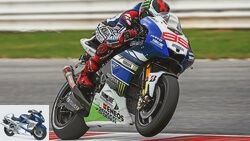
Motorsport
MotoGP seamless gears and technology in the Superbike World Championship
How’s it going and what’s the point?
read more
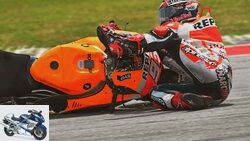
Station wagons, jackets & pants
Alpinestars racing service in MotoGP
What happens to a lintel station wagon?
read more
Crutchlow is the toughest tester. And crazy.
Bortolozzo finds Crutchlow’s personal braking style crazy but fascinating. “He’s our toughest tester,” says Bortolozzo, “if our parts survive a Crutchlow race, they’re good for all drivers.” “The real performance of a braking system is not the braking power it generates, but the ability to control how this braking power is generated. The strength of the Brembo systems lies in the second phase of the braking maneuver, when the driver slowly releases the brake lever. It shouldn’t happen that the brake suddenly releases the front wheel and the motorcycle becomes surprisingly faster. “
Crutchlow’s brutal grip and quick brake pressure goes well with a technical quirk of MotoGP tires. Because the grippy racing skins work very differently than conventional tires approved for road traffic. “It is important to deform the tire as much as possible at the beginning of the braking process in order to increase the contact area with the road as much as possible and thus achieve the best possible grip,” explains Lorenzo Bortolozzo.
Fat 340 millimeter discs for Motegi
Usually, at the beginning of the season, drivers opt for the 18 or 20 millimeter offset variant on the handbrake lever and then use it all year round. With the brake calipers, where the pressure generated by the pilot arrives, they have no choice. The pliers, milled from a single block of an aluminum-lithium alloy, press the brake pads onto the brake discs with two pistons on each side. How they look exactly depends on the circumstances of the current racetrack. There are three types of carbon brake discs: those with a diameter of 320 millimeters in a standard version and in a version with more mass, as well as a 340 millimeter disc with a high mass. Like brake pads, they are necessary with differently sized contact surfaces in order to get the temperature problem under control. Carbon fiber brakes do not work when they are too cool or when they overheat, which leads to different aerodynamic solutions from race to race, including the wheel covers and the cooling air flows. The standard 320 mm discs are used on routes such as Assen, which with fast corners and long straights do not place any special demands on the braking system. The fat 340-millimeter discs, on the other hand, have to run on courses like Motegi, where the brakes are a lot and hard.
Rear brake as traction control
A word about the rear brakes – at a time when MotoGP riders come with the rear wheel in the air almost by default when braking into a corner. “Because of the high braking effect of the four-stroke engines, it is actually of no use on the straight,” confirms Andrea Dovizioso, “but it is very important to use it in the final phase of cornering. If you let go of the front brake, pull up the gas and then the rear wheel begins to spin, you can easily use the rear brake. It’s not easy, but if you can manage it, it helps to stabilize the motorcycle. “The riders use the rear brake as a kind of traction control, as Brembo technician Bortolozzo knows:” And in very different ways. That is why there are even more configuration options for the rear brake than for the front wheel – right up to thumb operation, because it is sometimes not possible with the foot in an extremely inclined position. “
A respectable 87 of the 91 riders registered in the three classes Moto3, Moto2 and MotoGP 2014 trusted in Brembo brakes – a great marketing success, one would think. But it’s a very subtle one. Because when strolling through the MotoGP paddock there are no Brembo stickers to be found on the trucks of the teams – except on the comparatively small workshop vehicle used by Lorenzo Bortolozzo and his team. Brembo spokesman Massimo Arduini explains: “Brembo is not sponsoring the MotoGP World Championship. All teams pay for the parts they get from us – without exception. “
How much does a MotoGP brake system cost?
That naturally raises the question: What does a brake system like this for the factory Honda of world champion Marc Márquez cost? The Brembo people get monosyllabic. “In the MotoGP class, we develop our development efforts for 25 motorcycles,” says manager Roberto Pellegrino, “if we design a braking system for Harley-Davidson, for example, it is about 25,000 units – that cannot be compared.” But much can be said: If you want to equip your road legal Honda Fireblade with the finest Brembo technology on the front wheel, you don’t have to invest 2000 euros. In the Superbike World Championship, a Brembo brake system costs around 8,000 euros per motorcycle. The Brembo equipment that Marc Márquez and his colleagues drive for a walk is likely – a cautious estimate – to be ten times as expensive. Whereby it’s probably less about what the parts cost than about what Brembo required for it. The MotoGP heroes certainly have good reasons for staying loyal to the Bergamo brand with more than 50 years of experience in brake construction.
Top values MotoGP brakes
-1.8 g
is the maximum delay a MotoGP rider is exposed to over the year – at the Texas GP.
11 kg
is the greatest force with which MotoGP riders apply the brake lever – at the GP in Texas.
250 km / h
is the speed difference from the beginning to the end of the braking phase – before the first corner on the Doha race track.
361 km / h
is the maximum speed of a MotoGP motorcycle at the beginning of the braking process – on the start / finish straight in Mugello.
35 percent
One lap MotoGP drivers are busy braking – at the GP in Argentina.
333 meters
long is the longest braking phase in the MotoGP circuit – in Texas and in Brno.
17.4 kWh
maximum braking power is produced during a MotoGP race – at the World Championship run in Houston / Texas.
Related articles
-
Everything about motorcycle brakes
fact counselor workshop Everything about motorcycle brakes Everything about motorcycle brakes Brake system report Progress through perfect standstill….
-
Motorcycle technology – maintaining drum brakes, part 1
Marcel Schoch 50 pictures Marcel Schoch 1/50 After two passes with a total of two tenths of a material removal, the brake drum is ready for use again….
-
accesories Service special brakes Service special brakes Technology brake discs Ceramic brake discs are the latest hit. MOTORRAD had the opportunity to…
-
Recall Triumph Rocket III: Air on the brakes
triumph 9 pictures triumph 1/9 Even more displacement and Newton meters, but at the same time the weight screwed down. Does not sound bad. triumph 2/9…
-
Pascal Eckhardt’s driving tips for brakes
archive counselor workshop Pascal Eckhardt’s driving tips for brakes Pascal Eckhardt’s driving tips for the racetrack Part 6 – Brakes Content of If you…
-
MotoGP – Dorna boss Carmelo Ezpeleta in portrait
2snap Sports & scene Motorsport MotoGP – Dorna boss Carmelo Ezpeleta in portrait MotoGP – Dorna boss Carmelo Ezpeleta in portrait The show master Excited…
-
Brake performance in comparison: MotoGP versus Formula 1
Brembo Sports & scene Motorsport Brake performance in comparison: MotoGP versus Formula 1 Brake performance in comparison: MotoGP versus Formula 1 At the…
-
Temperatures on the motorcycle: MotoGP really is that hot
Moto GP Sports & scene Motorsport Temperatures on the motorcycle: MotoGP is really that hot It’s so hot at MotoGP Grilling for advanced users Gas grill…
-
2snap 24 pictures 2snap 1/24 2snap 2/24 2snap 3/24 2snap 4/24 2snap 5/24 2snap 6/24 2snap 7/24 2snap 8/24 2snap 9/24 2snap 10/24 2snap 11/24 2snap 12/24…
-
Zonko’s attack Red Bull MotoGP Rookies Cup
andreasriedmann.at 22nd pictures andreasriedmann.at 1/22 The bikes are lined up and ready for 120 talents who want to prove themselves on the two-stroke…